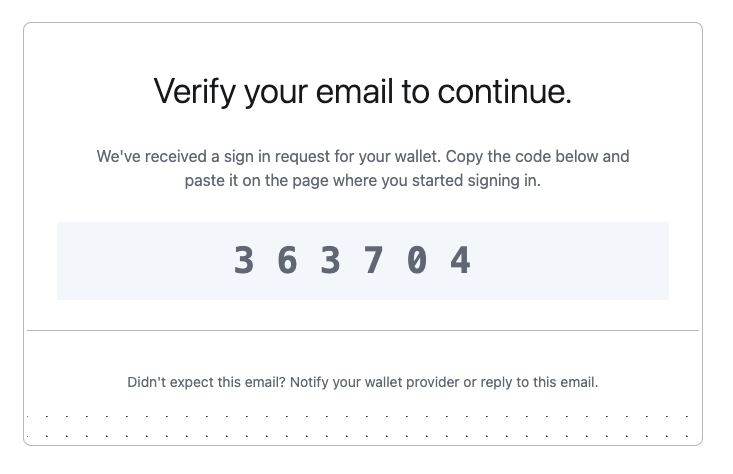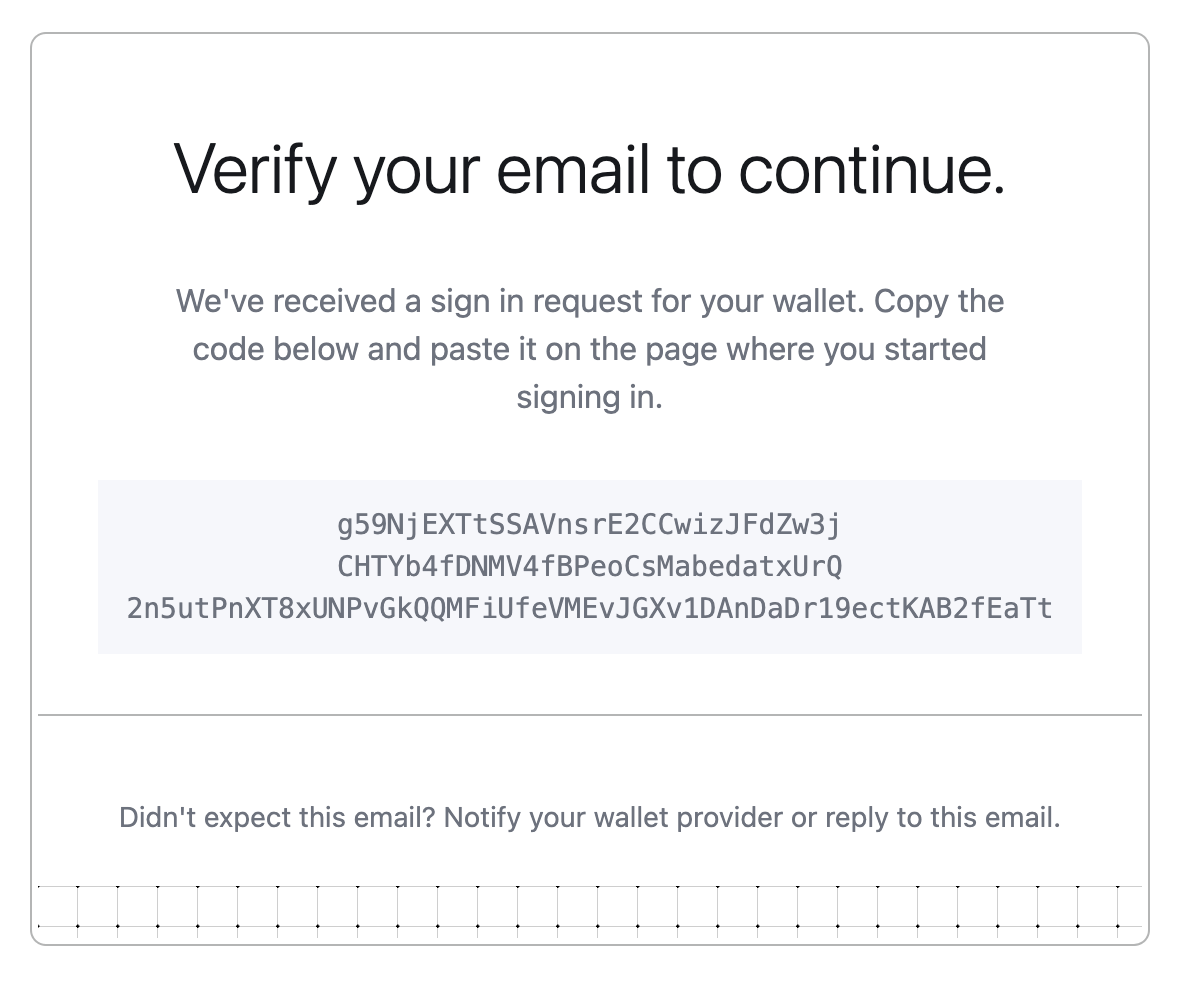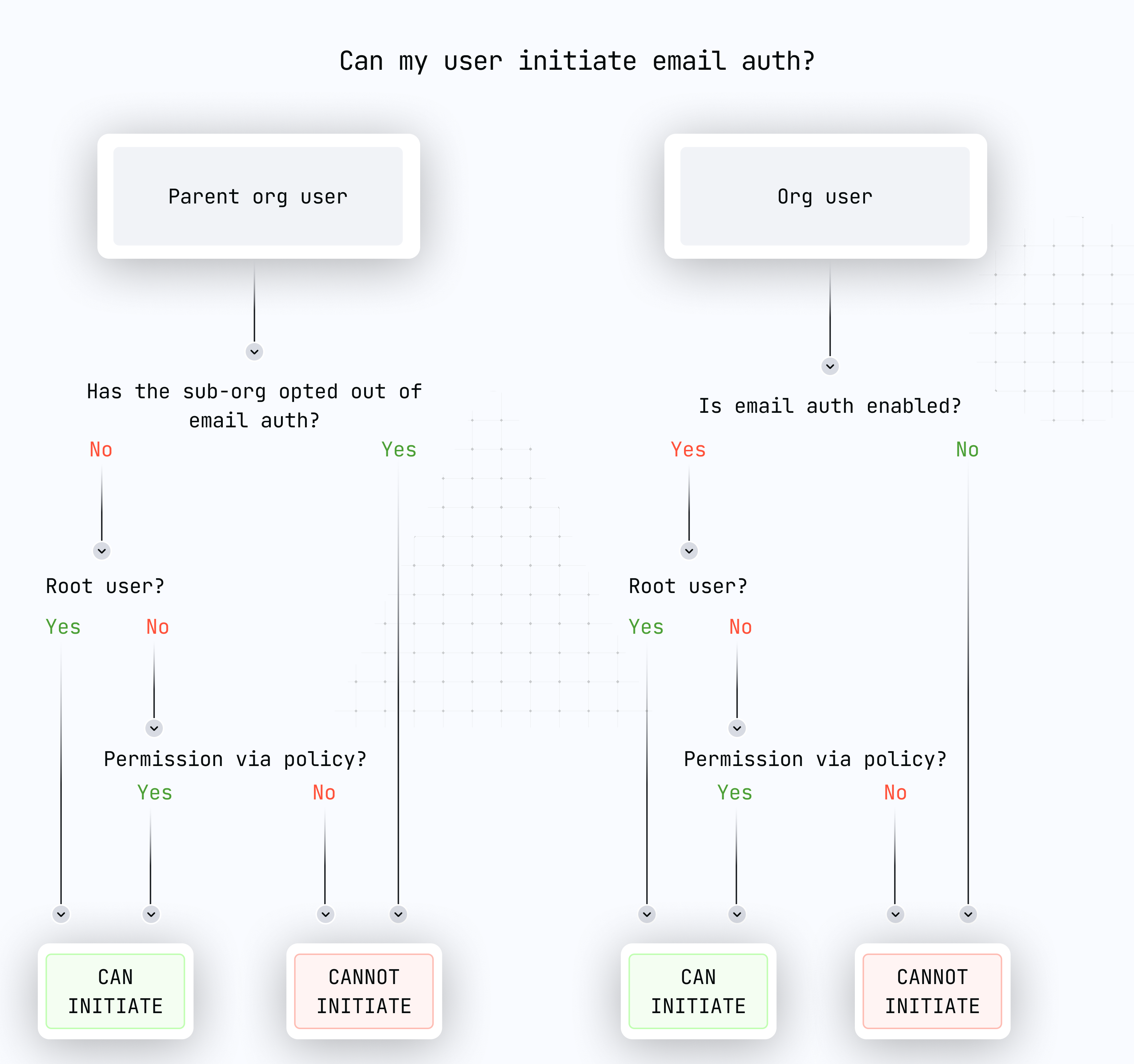- Uses a 6-digit one-time password sent via email
- Simple, and familiar user experience
- Sends an encrypted API key credential directly via email
- Alternative method for specific use cases
- More secure, but requires copying the full credential to the client
Core Mechanism
Email Authentication is built with expiring API keys as the foundation. The two delivery mechanisms are:OTP-based Method
The authentication process happens in two steps:1
A 6-digit OTP code is sent to the user’s verified email address
2
Upon verification of the correct code, an API key credential is generated
and encrypted for the client
Credential Bundle Method
The API key credential is encrypted and delivered directly through email to the user. In both cases, once the credential is live on the client side (within the context of an iframe), it is readily available to stamp (authenticate) requests. See the enclave to end-user secure channel for more info on how we achieve secure delivery.User Experience
OTP-based Authentication Flow
The flow begins with a new activity of typeACTIVITY_TYPE_INIT_OTP_AUTH with these parameters:
otpType: specify"OTP_TYPE_EMAIL"contact: user’s email address (must match their registered email)emailCustomization: optional parameters for customizing emailsuserIdentifier: optional parameter for rate limiting SMS OTP requests per user. We recommend generating this server-side based on the user’s IP address or public key. See the OTP Rate Limits section below for more details.
ACTIVITY_TYPE_OTP_AUTH:
otpId: ID from the init activityotpCode: the 6-digit code received via emailtargetPublicKey: public key for credential encryptionapiKeyName: optional name (defaults toOTP Auth - <Timestamp>)expirationSeconds: optional validity window (defaults to 15 minutes)invalidateExisting: optional boolean to invalidate previous OTP Auth API keys

OTP Rate Limits
In order to safeguard users, Turnkey enforces rate limits for OTP auth activities. If auserIdentifier parameter is provided, the following limits are enforced:
- 3 requests per 3 minutes per unique
userIdentifier - 3 retries max per code, after which point that code will be locked
- 3 active codes per user, each with a 5 minute TTL
Credential Bundle Authentication Flow
This alternative method usesACTIVITY_TYPE_EMAIL_AUTH with these parameters:
email: user’s email address (must match their registered email)targetPublicKey: public key for credential encryptionapiKeyName: optional name (defaults toEmail Auth - <Timestamp>)expirationSeconds: optional validity window (defaults to 15 minutes)emailCustomization: optional parameters for customizing emailsinvalidateExisting: optional boolean to invalidate previous Email Auth API keys

Recovery Flow
For account recovery scenarios, users can initiate a recovery-specific flow using theACTIVITY_TYPE_INIT_USER_EMAIL_RECOVERY activity type, which requires:
email: the email of the user needing recovery (must match their registered email)targetPublicKey: the public key for recovery credential encryption
- Initiation: Generates a temporary recovery credential and sends it via email
- Finalization: User decrypts the recovery credential and uses it to sign an
ACTIVITY_TYPE_RECOVER_USERactivity, which can add new authenticators to regain account access

Authorization
Authorization is managed through our policy engine:Authentication
Both OTP-based and credential bundle authentication activities:- Can be performed by root users and users with proper policy authorization
- Require the respective feature to be enabled in the organization and sub-organization
- Can target any user in the organization or sub-organizations
- For OTP-based auth:
ACTIVITY_TYPE_INIT_OTP_AUTHandACTIVITY_TYPE_OTP_AUTH - For credential bundle auth:
ACTIVITY_TYPE_EMAIL_AUTH
Recovery
-
ACTIVITY_TYPE_INIT_USER_EMAIL_RECOVERY:- Initiates the recovery process
- Requires proper authorization via policies
- Can target any user in the organization or sub-organizations
-
ACTIVITY_TYPE_RECOVER_USER:- Must be signed by the recovery credential received via email
- Users can add credentials to their own user when authenticated
- Recovery credentials expire after 15 minutes
- Only the most recent recovery credential remains valid
- Users can add new authenticators to regain account access when authenticated with a recovery credential

Implementation in Sub-organizations
Both authentication methods and recovery work seamlessly with sub-organizations.Example Implementations
For implementation details:Implementation in Organizations
For organizations accessed via dashboard:-
Ensure the required features are enabled:
FEATURE_NAME_OTP_EMAIL_AUTHfor OTP-based authenticationFEATURE_NAME_EMAIL_AUTHfor credential bundle authentication- Recovery features if needed
- Users initiating the request must have appropriate permissions
Opting Out
Organizations can disable email-based features if their security model requires it: UseACTIVITY_TYPE_REMOVE_ORGANIZATION_FEATURE to disable:
FEATURE_NAME_OTP_EMAIL_AUTHfor OTP-based authenticationFEATURE_NAME_EMAIL_AUTHfor credential bundle authenticationFEATURE_NAME_EMAIL_RECOVERYfor recovery
disableOtpEmailAuthparameter for OTP-based authenticationdisableEmailAuthparameter for credential bundle authenticationdisableEmailRecoveryparameter for recovery
Implementation Notes
-
Users are limited to:
- 10 long-lived API keys
- 10 expiring API keys (oldest are discarded when limit is reached)
For Top-level Organizations
- Both authentication methods are disabled by default
- Must be enabled via
ACTIVITY_TYPE_SET_ORGANIZATION_FEATURE
For Sub-organizations
- Both authentication methods are enabled by default
- Can be disabled during creation using
CreateSubOrganizationIntentV7activity parameters

